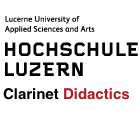John Moses
The Interview with John Moses, woodwind specialist, lecturer and educator took place on June 7th, 2019 at the Gershwin Theatre in New York and was edited by Heinrich Mätzener.
John Moses’ teachers
HM: The purpose of this project is to follow the traces of Daniel Bonade and Ralph McLane, who in turn were educated according to the old French school and were important personalities forming a lot of famous clarinetists in the USA in during the 20th
century. I think that you have also partially completed your studies in this tradition.
JM: [I studied] in the Older French School, although they [my teachers] called themselves [representatives of] the American School, which was a combination of a kind of Bonade, and also Kal Opperman. [Also] the German School of playing was very, very popular here. There was also a kind of “Italian School”. That came from Gino Cioffi. He was a kind of leading exponent of this school and I went to Boston to study with him and got a different idea. He played a crystal mouthpiece, and a Selmer clarinet and had a different sound from German or French.
HM: So, you know really…
JM: All the different influences, exactly. Because I was in New York with many of the German School teachers, a lot of them were here.
HM: Was New York more orientated to the German School than in Philadelphia?
JM: No, I think, more French. But there was a strong German influence also in New York, and guys went back and forth to different teachers. So, I went to Harold Wright, he was in Washington DC at that time. He was probably a really great example of the [Old] French School, with a little bit of German mixed in, because his tone was dark, but he had that sparkle of French, which was amazing! We called him “Buddy” but his name was Harold Wright. And then there was Anthony Gigliotti, who was in Philadelphia, who I also studied with.
HM: Gigliotti was a student of Daniel Bonade. JM: Exactly. And he had more of a French style playing. Although he loved the Italian sound that Cioffi got, he didn’t imitate that Italian School, he was more in the French School. But the best example I had as a teacher was Joe Allard.
HM: Is he still alive?
JM: No, Joe passed away about 10 years ago. I studied with him at Juilliard, for many years, and many of the great players in New York at least studied with Joe Allard or with someone who had been a student of him. So Joe was one of the biggest influences on many of the clarinet players in New York, and I think he was from French Canada, like Quebec. But he was really a very French School Canadian and taught the embouchure of the French and didn’t like the German concept at all! So when you went to Joe, you got the French concept [Joe Allard studied during four years with %https://en.wikipedia.org/wiki/Gaston_Hamelin Gaston Hamelin].
HM: Was he a student of Bonade also?
JM: Yes, he was. And of Augustin Duquès, a very famous teacher here also. Joe and Duques were both at Juilliard when I was there. So they were always talking to each other in French and making sure their students got the French concept.
<bfr>
HM: I see.
JM: But Duques was also a student of Bonade and they all loved the French School!
